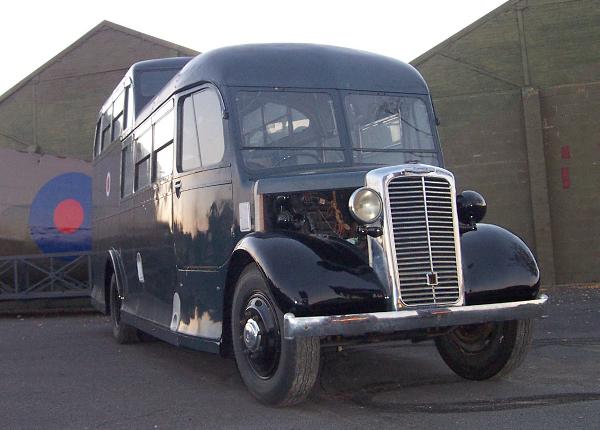|
RAF Crew
Bus
A
superb example of a 1947 Commer Commando Crew Bus used by the Royal Air Force on
Yorkshire airfields has been secured as the latest addition to the Yorkshire Air
Museum's historic vehicle collection. The vehicle was offered for sale by our
friends at the Lincolnshire Aviation Heritage Centre, East Kirkby and the museum
acted without hesitation to purchase the vehicle and bring it to the museum in
view of the historic significance and condition of the bus. It is the oldest
surviving Commer Commando one and a half decker bus and in 1999 was one of only
5 remaining examples and could be even rarer now.

Under
the care and ownership of the Panton brothers at their Lincolnshire base, the
Crew Bus raised substantial funds for the RAF Benevolent Fund after repaying the
investment made by the General Engineering Flight at RAF Cottesmore, who
undertook the complete restoration of the vehicle. David Hardcastle, who
purchased the bus in 1978, originally donated the bus to the Flight. A tragic
story lies behind the restoration of the bus. David Hadrcastle's mother wanted
to give something back to the RAF Benevolent Fund, who had helped her when she
was widowed six weeks after her wedding to her first husband, Sgt. Frank
Wilkinson, of Huddersfield, who was killed flying a Vickers Wildebeest of 22
Squadron on 4th June 1937. In conditions of poor visibility, the aircraft hit
high ground at Crinkle Crags, near Grasmere, killing both crewmembers, Sgt
Wilkinson and LAC Alexander Mitchell. David gifted the Commando to the RAFBF
with a view to its restoration as a Public Relations and fundraising aid.

The
actual service history of XAT 368 is long and interesting. It was delivered to
the RAF in April 1947 and served at various Yorkshire airfields, before being
sold at auction at Ruddington, Nottinghamshire in October 1957. New owners Hull
Cricket Club found it slow, causing the team to frequently arrive late for
matches, although it was good for holding kit! However, a new gearbox cured this
problem, but after two years, it was sold on to Newall Engineering, as a staff
bus. It then passed to two commercial operators, Primrose Valley Garage &
Coaches and W& H Lamb. Possibly due ton the fact that it only had 21 seats,
it proved uneconomical as a coach and was only in such service for seven months.
It seems to have been mothballed before being sold to the British Auto Racing
Club in June 1962 for use as a race control vehicle. This saw the removal of
many of the seats and reconfiguration as a mobile office, with desks and tables.
In this guise, it appeared at events at Harewood for the Stockton Farm
Hillclimb, meetings at Castle Howard, Scarborough and RAF Church Fenton, before
ending up at Siverstone. The new gearbox fitted whilst at Hull had transformed
the bus into a very good runner and a story told by one BARC member at the time
that on a journey to an event, he could not keep up with it, and he was doing at
least 70mph! Sadly, but almost inevitably, the bus fell into disrepair and was
last driven at Siverstone in 1972 and lay decaying until the purchase by David
Hardcastle in 1978. Despite David's intentions to restoring the vehicle, it
remained in a decaying state until he donated it to the RAFBF and the team at
RAF Cottesmore in October 1993.
It
is a tribute to the work done by the General Engineering Flight at Cottesmore
and the care it received since then at Lincolnshire that the vehicle is in the
excellent condition it is now. It is fully running, with the engine described as
being 'as sweet as a nut'. Some cosmetic work and electricals need attention on
the dashboard, but apart from that it is pristine. Not surprising, as it was
totally stripped, re-skinned, repainted, re-upholstered to original
specification and brought back into serviceable condition.
As
the fundraising role of the bus has now been more than adequately fulfilled, the
Lincolnshire team of volunteers were finding it increasingly difficult to
maintain the vehicle as well as the Lancaster and Spitfire in their cares,
which, understandably, take priority. This led to the reluctant decision to sell
the vehicle, but Fred and Harold Panton were keen to see it go to a good and
appropriate home and saw the Yorkshire Air Museum as the ideal location, should
we wish to purchase it.
There
is no doubt that their instincts were right and the vehicle has found what is
certain to be a loving home. The Commando has generated a lot of excitement and
enthusiasm already, since it arrived on Tuesday 7th November. It has gone
straight under cover whilst we assess the various possibilities for its display
and use in the future. It is sure to become a major attraction in its own right,
as there is a huge international following for historic vehicles such as this
and we are absolutely delighted that it is here.
The
purchase was made possibly by the museum's strong performance during the season,
which has seen a significant increase in gate and corporate revenue and it is
very satisfying to have been in a position to acquire such an interesting
artifact.
|